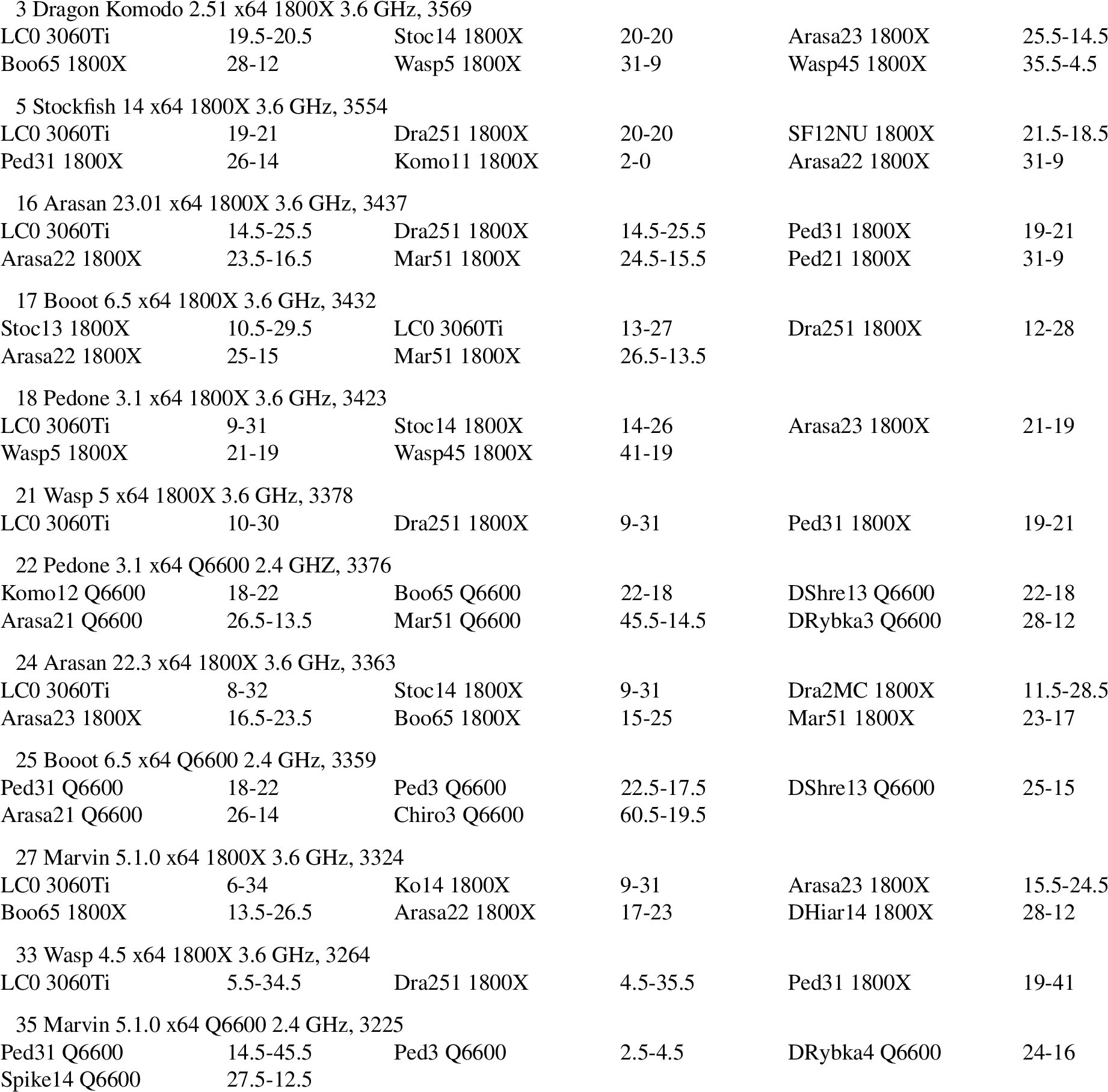The SSDF Chess Engine Rating List, 2022-01
This last list of 2021 and first list of 2022, will be dedicated in honor of the late Guy Haworth. On this new years list, we can present seven new programs on our two hardware levels.
First one out is Mark Lefler and Larry Kaufman’s latest version of Dragon Komodo, named 2.51. We have initially tested the non-MCTS version and after the first 240 games it has reached a rating of 3569, that is 22 points stronger than the last non-MCTS Dragon Komodo we tested. It is now just four points behind the leader from the last rating list – Lc0. It is also nine points below Stockfish 13 – which now has taken over the leader spot in the rating list. Dragon Komodo 2.51 is now more than 100 points stronger than the best non-NNUE version of Komodo we have tested! As before we have used the opening book “out10-35.bin” of Erdogan Gunes for the testing of Dragon Komodo.
Next one out is the latest creation from team Stockfish, namely Stockfish 14. After the first 202 games it has reached a rating of 3554, which is 24 points behind Stockfish 13 in first place, and 4 points behind Stockfish 12. For the testing of Stockfish 14 we have used the opening book by Fauzi Dabat named “Aggressive 5.0 by Fauzi.abk”. More games will probably be needed to stabilise the rating against the other engines in the top, lower the error bars and see if it will be able to supersede the older version as more games are played.
We have also tested two new engines from Jon Dart, named Arasan 22.3 and the neural network architecture (NNUE) version named 23.01. For the testing of these two engines, we have used Arasan’s own opening book. Arasan 22.3 has reached the rating of 3363 after the 240 games. This is 78 points stronger than the last Arasan 21.2 version we have tested. The NNUE version: Arasan 23.01, has then gained a further 74 points on that, resulting in the rating of 3437 after the first 240 games.
We also have the latest (and last) free Pedone-version in this rating list. It is Pedone 3.1 by Fabio Gobbato. Like the 3.0-version of the same program, it uses NNUE in the search. We have tested it on both our hardware levels. On the 1800X – Pedone 3.1 has reached a rating of 3423 after 220 games played. On the Q6600 hardware, Pedone 3.1 has achieved a rating of 3376 after 260 games. The difference between the two hardware is 47 points, and Pedone 3.1 on the 1800X is 37 points stronger than Pedone 3.0 1800X. On the Q6600, the difference between Pedone 3.1 and 3.0 is 53 points. We have used Pedone’s own opening book for the testing of Pedone 3.1.
We can also present a rating of Alex Morozov’s latest Booot program, named Booot 6.5. We have tested this program on two of our hardware levels. On our 1800X hardware, Booot 6.5 has received a rating of 3432 after 200 games. On our Q6600 hardware, Booot 6.5 has reached a rating of 3359 after 240 games. The difference between the two different hardware is 73 points. The 6.5-version is 64 points ahead of the formerly tested Booot 6.4 on the 1800X and on the Q6600, the difference between Booot 6.5 and Booot 6.3.1 is 68 points. We have used Sedat Canbaz’s “Perfect2021.abk” for the testing of Booot 6.5.
We are also able to welcome a Swedish newcomer in this rating list! Probably the first Swedish program in the list after Per Ola Valfridsson’s–Ruffian, I guess? It is Martin Danielsson’s engine: Marvin 5.1.0, which we have tested on both our hardware levels. We have used Marvin’s own opening book for the testing. Marvin is from the 5.0.0-version a neural network architecture (NNUE)-program.On our 1800X hardware, Marvin 5.1.0 has reached a rating of 3324 after 240 games. On the Q6600 hardware, Marvin 5.1.0 has gotten a rating of 3225 after the first 147 games. The difference between the two hardware is just shy of 100 points.
Last, but not least, are the two Wasp-programs from John Stanback. The first one is Wasp 4.5, which uses ordinary search, and has received a rating of 3264 after the first 140 games. This is nine points ahead of the formerly tested Wasp 4. Wasp 5.0 uses a neural network for position evaluation. This has proven to be valuable for Wasp, and Wasp 5.0 1800X has received a rating of 3378 after the first 120 games. Albeit it’s early in the testing, the difference between the two versions is now 114 points at least! 
Table 1
The recently tested ‘Selected 50’ from SSDF rating list ‘2022-01’, 158725 games played by 418 computers

Table 1
(Continued)




